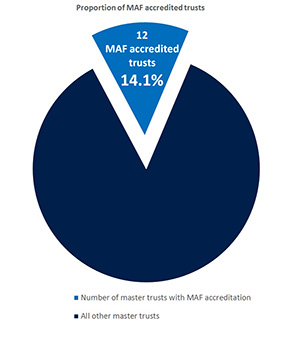From the blog: No one wants to be reading stories about pension scheme members suffering financial loss as a result of being enrolled into poorly managed mastertrusts.
The new regulations for mastertrusts are therefore to be welcomed.
But the devil will be in the detail, and it will be interesting to see how some of the criteria are expanded upon.
Click here to read the full blog post
In principle, the five key criteria announced in the pension schemes bill are likely to generate positive results in controlling new mastertrusts. But the devil will be in the detail, and it will be interesting to see how some of the criteria are expanded upon.
Ensuring a mastertrust has sufficient capital so members don't suffer should the trust fail seems sensible.
Achieving MAF does not just rely on a scheme having the right processes in place, it relies on the scheme paying an auditor to verify those processes on an annual basis
It will be interesting, however, to see how the term “sufficient” is defined. Recent press coverage suggesting all mastertrusts should have at least £2m of capital implies that one size fits all. In reality, a smaller mastertrust could transition to a new provider in the event of failure, with a much lower level of capital to hand.
Some mastertrusts have been established on a non-commercial basis by industries or employer groups and are therefore unlikely to have a large single sponsor backing the scheme.
Does this matter though, if the scheme has an income that covers its cost base and provides appropriate capital and contingency plans to protect members in the unlikely event the scheme should fail?
The same group of mastertrusts will probably be pleased to see that the pension schemes bill does not make the master trust assurance framework a mandatory requirement.
 Several industry figures immediately expressed their disappointment at this, but it was interesting to note that almost without exception they represented the largest schemes, who had already achieved MAF compliance.
Several industry figures immediately expressed their disappointment at this, but it was interesting to note that almost without exception they represented the largest schemes, who had already achieved MAF compliance.
Achieving MAF does not just rely on a scheme having the right processes in place, it relies on the scheme paying an auditor to verify those processes on an annual basis.
This is a significant and ongoing financial burden and may act as a barrier to entry for smaller, high-quality mastertrusts, some of which have already achieved Pensions Quality Mark status.
It would surely be incorrect to conclude that more than 85 per cent of UK mastertrusts are poorly run, and it has to be worth trying to identify more cost-effective methods of controlling quality.
Let’s hope the ‘compliance’ costs of running a good mastertrust will plateau rather than continually rise, allowing trustees to focus on the most important job: providing high quality, cost-efficient schemes that produce good retirement incomes for their members.
Phil Boyle is communications director at scheme services and mastertrust provider Ensign Pensions













